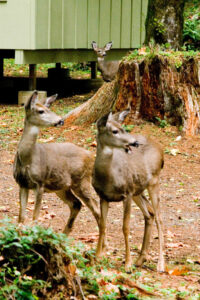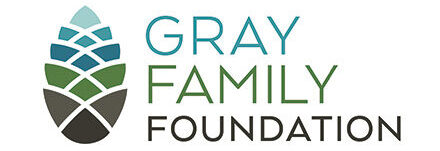 In past years, Oregon students have primarily learned the West-facing view of Oregon’s history—the one that focuses on the white pioneer expansion experience.
In past years, Oregon students have primarily learned the West-facing view of Oregon’s history—the one that focuses on the white pioneer expansion experience.
That tide is shifting. In 2017, the state enacted Oregon Senate Bill 13, an agreement between the state and tribes to ensure native perspectives are a part of the history curriculum across Oregon—and now that includes Outdoor School.
In the Portland area, the largest Outdoor School provider, the Multnomah Education Service District (MESD), utilized a three-year grant from the Gray Family Foundation to reimagine what more culturally inclusive Outdoor School programming could look like.
“We had taken a look at our curriculum and realized that it was not representing the true history of Oregon and wanted to make sure that it was more culturally inclusive, and also get the perspectives of Indigenous leaders in our region,” says Jennifer Basham, Senior Program Administrator for Outdoor School at MESD.
MESD coordinates Outdoor School for 10,000 Multnomah County students in fourth and sixth grades, along with high school camp leaders. The students attend one of a handful of MESD Outdoor School sites, including Camp Howard, Camp Collins, Camp Namanu, Canby Grove Camp, Camp Angelos and others.
Jennifer and her colleagues utilized the grant to assemble an advisory team to examine and transform the curriculum for fourth graders, where the pioneer-expansion narrative previously dominated. The team brought together area tribal leaders, district officials and Outdoor School leaders.
“The grant was really impactful because it allowed for us to take some time and dig in,” she says. “We shifted completely from a historic perspective and are making it more a land-based geography program.”
With its focus on the fourth grade, MESD’s efforts are also shining a light on the value of bringing students to Outdoor School before sixth grade. When fourth-graders get a taste of outdoor school—with parents alongside—they are much more equipped to do a residential program in sixth grade. The fourth-grade camp also provides opportunities to grow high-school camp leaders with a younger group.
“We’ve seen a really positive outcome from that, for both the students and the families,” Jennifer says.
Looking ahead, MESD will continue the work of centering Indigenous voices and collaborating with district partners to find ways in which this program might support and elevate Senate Bill 13. A pilot program this spring will help refine the new program offerings MESD will offer for Outdoor School in 2022 and beyond.
“We’ve been extremely grateful to the Gray Family to allow us to take this time to really critically examine and reflect on the program in a way that is meaningful and supportive of the true history of Oregon.”
In past years, Oregon students have primarily learned the West-facing view of Oregon’s history—the one that focuses on the white pioneer expansion experience.
That tide is shifting. In 2017, the state enacted Oregon Senate Bill 13, an agreement between the state and tribes to ensure native perspectives are a part of the history curriculum across Oregon—and now that includes Outdoor School.
In the Portland area, the largest Outdoor School provider, the Multnomah Education Service District (MESD), utilized a three-year grant from the Gray Family Foundation to reimagine what more culturally inclusive Outdoor School programming could look like.
“We had taken a look at our curriculum and realized that it was not representing the true history of Oregon and wanted to make sure that it was more culturally inclusive, and also get the perspectives of Indigenous leaders in our region,” says Jennifer Basham, Senior Program Administrator for Outdoor School at MESD.
MESD coordinates Outdoor School for 10,000 Multnomah County students in fourth and sixth grades, along with high school camp leaders. The students attend one of a handful of MESD Outdoor School sites, including Camp Howard, Camp Collins, Camp Namanu, Canby Grove Camp, Camp Angelos and others.
Jennifer and her colleagues utilized the grant to assemble an advisory team to examine and transform the curriculum for fourth graders, where the pioneer-expansion narrative previously dominated. The team brought together area tribal leaders, district officials and Outdoor School leaders.
“The grant was really impactful because it allowed for us to take some time and dig in,” she says. “We shifted completely from a historic perspective and are making it more a land-based geography program.”
With its focus on the fourth grade, MESD’s efforts are also shining a light on the value of bringing students to Outdoor School before sixth grade. When fourth-graders get a taste of outdoor school—with parents alongside—they are much more equipped to do a residential program in sixth grade. The fourth-grade camp also provides opportunities to grow high-school camp leaders with a younger group.
 “We’ve seen a really positive outcome from that, for both the students and the families,” Jennifer says.
“We’ve seen a really positive outcome from that, for both the students and the families,” Jennifer says.
Looking ahead, MESD will continue the work of centering Indigenous voices and collaborating with district partners to find ways in which this program might support and elevate Senate Bill 13. A pilot program this spring will help refine the new program offerings MESD will offer for Outdoor School in 2022 and beyond.
“We’ve been extremely grateful to the Gray Family to allow us to take this time to really critically examine and reflect on the program in a way that is meaningful and supportive of the true history of Oregon.”
